2017七年级英语上册第一单元备课教案
- 格式:docx
- 大小:17.19 KB
- 文档页数:7
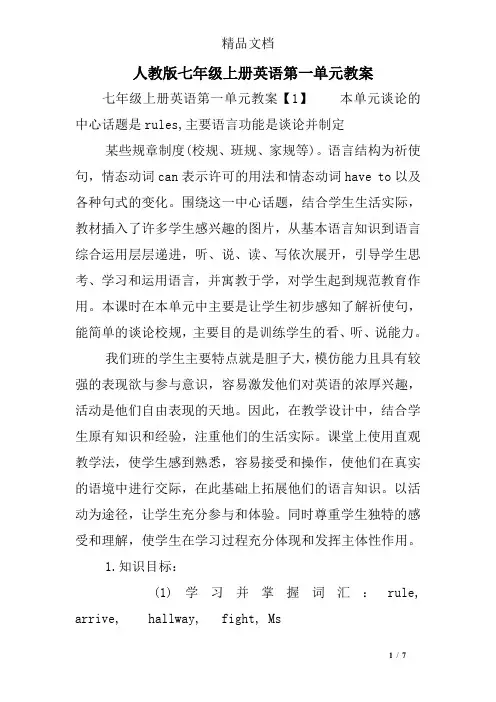
人教版七年级上册英语第一单元教案七年级上册英语第一单元教案【1】本单元谈论的中心话题是rules,主要语言功能是谈论并制定某些规章制度(校规、班规、家规等)。
语言结构为祈使句,情态动词can表示许可的用法和情态动词have to以及各种句式的变化。
围绕这一中心话题,结合学生生活实际,教材插入了许多学生感兴趣的图片,从基本语言知识到语言综合运用层层递进,听、说、读、写依次展开,引导学生思考、学习和运用语言,并寓教于学,对学生起到规范教育作用。
本课时在本单元中主要是让学生初步感知了解祈使句,能简单的谈论校规,主要目的是训练学生的看、听、说能力。
我们班的学生主要特点就是胆子大,模仿能力且具有较强的表现欲与参与意识,容易激发他们对英语的浓厚兴趣,活动是他们自由表现的天地。
因此,在教学设计中,结合学生原有知识和经验,注重他们的生活实际。
课堂上使用直观教学法,使学生感到熟悉,容易接受和操作,使他们在真实的语境中进行交际,在此基础上拓展他们的语言知识。
以活动为途径,让学生充分参与和体验。
同时尊重学生独特的感受和理解,使学生在学习过程充分体现和发挥主体性作用。
1.知识目标:(1)学习并掌握词汇:rule, arrive, hallway, fight, Ms(2)掌握交际用语:what are the rules?Don’t eat in class!Don’t listen to music in the classroom or the hallwaysDon’t arrive late for classDon’t run in the hallwaysDon’t fight.2.能力目标国家英语课程标准规定初一年级结束时,学生英语水平要达到三级水平。
听:能听懂有关熟悉话题的语段。
说:1.能在课堂活动中用简短的英语进行交际。
2.能就熟悉的话题进行简单的交流。
3.能在教师的指导下参与简单的游戏和角色扮演活动。
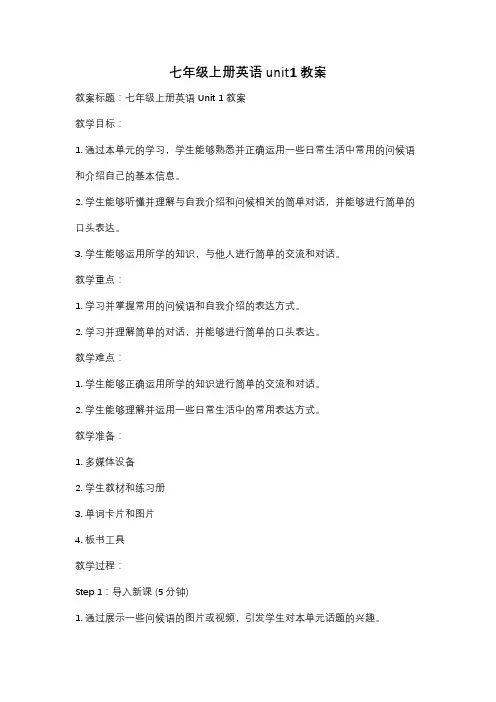
七年级上册英语unit1教案教案标题:七年级上册英语 Unit 1 教案教学目标:1. 通过本单元的学习,学生能够熟悉并正确运用一些日常生活中常用的问候语和介绍自己的基本信息。
2. 学生能够听懂并理解与自我介绍和问候相关的简单对话,并能够进行简单的口头表达。
3. 学生能够运用所学的知识,与他人进行简单的交流和对话。
教学重点:1. 学习并掌握常用的问候语和自我介绍的表达方式。
2. 学习并理解简单的对话,并能够进行简单的口头表达。
教学难点:1. 学生能够正确运用所学的知识进行简单的交流和对话。
2. 学生能够理解并运用一些日常生活中的常用表达方式。
教学准备:1. 多媒体设备2. 学生教材和练习册3. 单词卡片和图片4. 板书工具教学过程:Step 1:导入新课 (5分钟)1. 通过展示一些问候语的图片或视频,引发学生对本单元话题的兴趣。
2. 向学生提问,引导他们回忆并分享自己在日常生活中常用的问候语。
Step 2:新课讲解 (15分钟)1. 教师通过多媒体展示幻灯片或板书,介绍并讲解本单元的目标和重点内容。
2. 教师逐一讲解和演示常用的问候语和自我介绍的表达方式,并引导学生进行模仿和练习。
3. 教师通过示范对话,让学生理解并掌握如何进行简单的交流和对话。
Step 3:练习与巩固 (20分钟)1. 学生进行小组活动,每组选择一位代表进行自我介绍,其他组员进行提问和回答。
2. 学生进行角色扮演,模拟真实生活场景中的问候和自我介绍对话,并与同伴进行互动练习。
3. 教师组织游戏活动,如快速问候比赛,让学生通过游戏巩固所学的问候语和自我介绍的表达方式。
Step 4:拓展与应用 (10分钟)1. 学生根据教师提供的情景,编写简短的对话,并进行表演。
2. 学生自由发挥,与同伴进行真实的交流和对话,运用所学的知识进行实际应用。
Step 5:课堂总结 (5分钟)1. 教师对本节课的重点内容进行总结,并强调学生在日常生活中的实际应用价值。
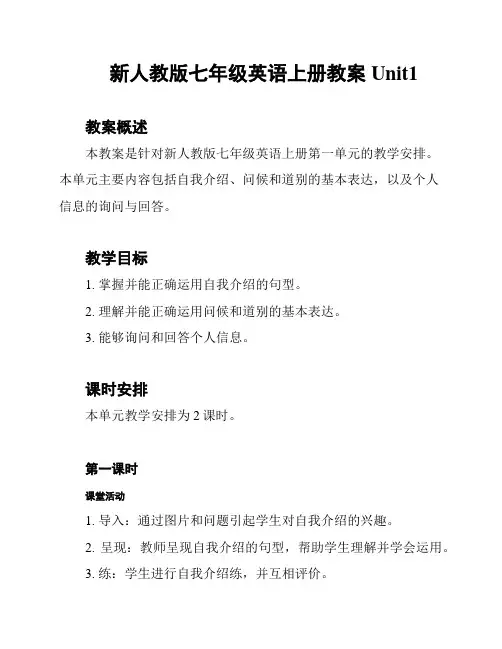
新人教版七年级英语上册教案Unit1教案概述本教案是针对新人教版七年级英语上册第一单元的教学安排。
本单元主要内容包括自我介绍、问候和道别的基本表达,以及个人信息的询问与回答。
教学目标1. 掌握并能正确运用自我介绍的句型。
2. 理解并能正确运用问候和道别的基本表达。
3. 能够询问和回答个人信息。
课时安排本单元教学安排为2课时。
第一课时课堂活动1. 导入:通过图片和问题引起学生对自我介绍的兴趣。
2. 呈现:教师呈现自我介绍的句型,帮助学生理解并学会运用。
3. 练:学生进行自我介绍练,并互相评价。
4. 拓展:教师向学生介绍不同国家的问候俗,进行讨论。
教学重点1. 自我介绍的句型。
2. 问候和道别的基本表达。
教学难点1. 自我介绍的运用。
2. 问候和道别的实际应用。
第二课时课堂活动1. 复:教师通过问题和游戏复第一课时所学内容。
2. 呈现:教师呈现个人信息的询问和回答的句型,并帮助学生掌握。
3. 练:学生进行个人信息的询问和回答练。
4. 拓展:教师引导学生探讨不同国家的个人信息俗。
教学重点1. 个人信息的询问和回答的句型。
2. 运用个人信息进行实际对话。
教学难点1. 实际运用个人信息进行对话。
2. 理解不同国家的个人信息俗。
教学评价本教案的教学评价将以学生在课堂上的参与度、语言表达能力和对内容的理解程度为主要评价指标。
参考资料1. 新人教版七年级英语上册教材。
2. 英语教学参考书。
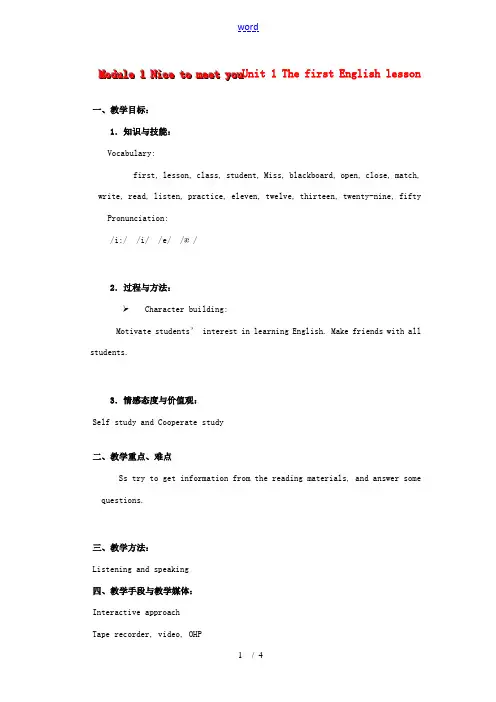
M M o o d d u u l l e e11N N i i c c e e t t o o m m e e e e t t y y o o u u Unit 1 The first English lesson 一、教学目标:1.知识与技能:Vocabulary:first, lesson, class, student, Miss, blackboard, open, close, match, write, read, listen, practice, eleven, twelve, thirteen, twenty-nine, fifty Pronunciation:/i:/ /i/ /e/ /æ /2.过程与方法:➢Character building:Motivate students’ interest in learning English. Make friends with all students.3.情感态度与价值观:Self study and Cooperate study二、教学重点、难点Ss try to get information from the reading materials, and answer some questions.三、教学方法:Listening and speaking四、教学手段与教学媒体:Interactive approachTape recorder, video, OHP五、课时安排:1.1六、教学过程:Step 1 (warm up)Introduction . Using these ways.My Chinese name is ShenJinhu. My English name is Jane. I’m an English t eacher. You can call me Mr.Shen. I’m 33 years old. I’m from Tianjin, China. I’m Chinese. I teach in TianjinExperimentalJuniorMiddle School. You’re my students. We’re good friends.Step 2:Ask students to introduce themselves with this pattern.Remember these language points:1) My Chinese / English name is…2) I’m a student.3) I’m …years old.4) I’m from…5) I study in TianjinExperimentalJuniorMiddle School.6) We’re your students.7) We’re good friends, too.Step 3:Listen to the conversation of Activity 3. Ask students to listen without opening their books. Then answer myquestions.Q1:What’s the teacher’s family name?Q2: Where’s she from?Q3: Is she Chinese or English?Q4: What’s the first girl’s name?Q5: Where’s she from?Q6: What’s the boy’s name?Q7: Is he from Beijing, too?Q8: How old are Lingling and Daming?Q9: What’s the second boy’s name?Q10: Where’s he from?Step 4:Ask students to retell the conversation and create anew one with their own real life.Step 5:Do listening of Activity 1 and Activity 6.Step 6:Do writing with the words of Activity 2.I can show them a model before writing. After writing, I’llread the good ones to the students in order to encourage themto write more. After that, ask students to evaluate whosewriting is the best, etc.Hello, class! I’m your English teacher. I’m Chinese. You can call me Miss Xie. You are my students. I hope we’re friends in the school. All the teachers are kind. They are as good asyour father and mother.Step 7:Learn, watch and do the actions about the words ofActivity 8.七、板书:The new words:Chinese, class, father, friend, mother, student, teacherThe drills:1) My Chinese / English name is…2) I’m a student.3) I’m …years old.4) I’m from…5) I study in TianjinExperimentalJuniorMiddle School.6) We’re your students.7) We’re good friends, too.八、课后反思:When we learn this part, we should ask students to relax. This is an easy time and play the game with Bingo.。
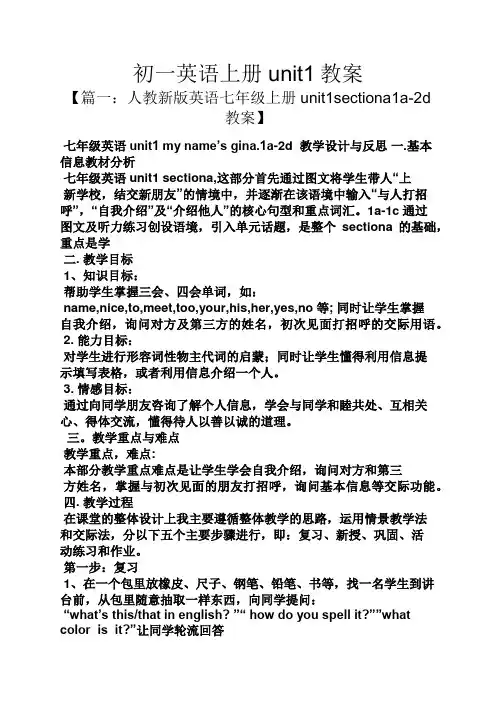
初一英语上册unit1教案【篇一:人教新版英语七年级上册unit1sectiona1a-2d教案】七年级英语unit1 my name’s gina.1a-2d 教学设计与反思一.基本信息教材分析七年级英语unit1 sectiona,这部分首先通过图文将学生带人“上新学校,结交新朋友”的情境中,并逐渐在该语境中输入“与人打招呼”,“自我介绍”及“介绍他人”的核心句型和重点词汇。
1a-1c通过图文及听力练习创设语境,引入单元话题,是整个sectiona的基础,重点是学二. 教学目标1、知识目标:帮助学生掌握三会、四会单词,如:name,nice,to,meet,too,your,his,her,yes,no等; 同时让学生掌握自我介绍,询问对方及第三方的姓名,初次见面打招呼的交际用语。
2. 能力目标:对学生进行形容词性物主代词的启蒙;同时让学生懂得利用信息提示填写表格,或者利用信息介绍一个人。
3. 情感目标:通过向同学朋友咨询了解个人信息,学会与同学和睦共处、互相关心、得体交流,懂得待人以善以诚的道理。
三。
教学重点与难点教学重点,难点:本部分教学重点难点是让学生学会自我介绍,询问对方和第三方姓名,掌握与初次见面的朋友打招呼,询问基本信息等交际功能。
四. 教学过程在课堂的整体设计上我主要遵循整体教学的思路,运用情景教学法和交际法,分以下五个主要步骤进行,即:复习、新授、巩固、活动练习和作业。
第一步:复习1、在一个包里放橡皮、尺子、钢笔、铅笔、书等,找一名学生到讲台前,从包里随意抽取一样东西,向同学提问:“what’s this/that in english? ”“ how do you spell it?””whatc olor is it?”让同学轮流回答2、双人活动。
复习句型: is this/that a/an ??每个同学拿几样东西相互提问:s1: is this an apple?s2: yes, it is. /no, it isn’t. it’s a/an ?第二步:新授1.1a这个活动是以词汇教学为主要内容,其目的是了解学生的英语基础,同时也是教学新知识前的热身,还可以是对预备篇教学内容的复习。
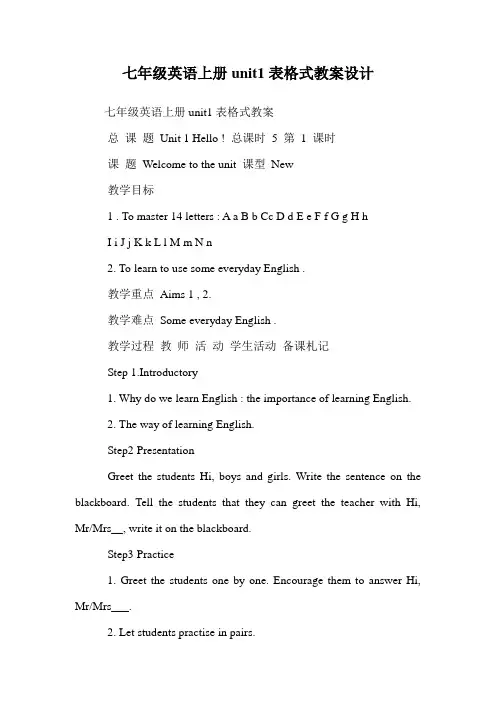
七年级英语上册unit1表格式教案设计七年级英语上册unit1表格式教案总课题Unit 1 Hello ! 总课时5 第1 课时课题Welcome to the unit 课型New教学目标1 . To master 14 letters : A a B b Cc D d E e F f G g H hI i J j K k L l M m N n2. To learn to use some everyday English .教学重点Aims 1 , 2.教学难点Some everyday English .教学过程教师活动学生活动备课札记Step 1.Introductory1. Why do we learn English : the importance of learning English.2. The way of learning English.Step2 PresentationGreet the students Hi, boys and girls. Write the sentence on the blackboard. Tell the students that they can greet the teacher with Hi, Mr/Mrs__, write it on the blackboard.Step3 Practice1. Greet the students one by one. Encourage them to answer Hi, Mr/Mrs___.2. Let students practise in pairs.Step 4 PresentationLearn the letters A----N and their phonetic symbols (Form A to N)Step 5 PracticeLearn some words beginning with these letters and learn their phonetic symbols.apple; ball; cat; dog; egg; fish; girl; hat; ice-cream; juice; kite; like; mouse; nose;Listen and read .Listen and learnLearn how to writethe letters.教师活动学生活动备课札记Step 6 Teach everyday EnglishExplain and teach some everyday English1) ------ Good morning / afternoon , class .------ Good morning /afternoon, Mr/ Mrs ..2) ----- Hello ! ------- Hi !3) ------ Goodbye , class .------ Goodbye , Mr. / Miss .. ( see you.)Step 7 ConsolidationRead through the contents learned .Step 8 Assignment1) Read and copy the letters Aa ---- Nn threetimes.2) Learn to use the everyday English .Read and learn .Go over the content on the Bb.Finish the homework .教学反思总课题Unit 1 Hello ! 总课时5 第2课时课题Listening 课型New教学目标1 . To master 12 letters : O o P p Q q R r Ss T t Uu Vv W w X x Y y Z z2. To learn to use some everyday English .教学重点Aims 1 , 2.教学难点Some everyday English .教学过程教师活动学生活动备课札记Step 1 Revision1) Have a simple dialogue with the Ss toreview everyday English .2) Dictate the letters ( A a ---- N n )Step 2 Teach letters1 Teach the letters1) Teach the Ss how to read O o P p Q q R r Ss T t Uu Vv W w Xx Y y Z zThen play the tape for the Ss to listen and read the letters twice and get the Ssto practise them in groups .2) Show the Ss how to write these twice .3) Tell the Ss some letter groups’ meanings.HK (香港)CD(光盘) ID (身份证)NBA(全美篮球协会) a.m. kgKFC(肯得基) DJ(电台节目主持人)Act out a dialogue .Have a dictation .Listen read and learn .Learn to write the letters .Listen read and learn.教师活动学生活动备课札记Step 3 Teach everyday EnglishExplain and teach some everyday English1) ------- How are you ? ------- Fine, thankyou . And you ?------- I’m fine ,too.2) Stand up, please . Sit down , please .Step 4ConsolidationRead through the contents learned .Step 5 Assignment1)Read and copy the letters Oo ----- Zz three times.2) Learn to use everyday English .Learn to say some everyday English .教学反思总课题Unit 1 Hello ! 总课时5 第3 课时课题Speaking 课型New教学目标1 Master daily English What’s your name ? I’m .. You’re Nick , right ? Yes , I’m . / No, I’m not .2. Review the letters and everyday Englihs learned.教学重点Aims 1 , 2.教学难点Master daily expressions and use them in daily life . 教学过程教师活动学生活动备课札记Step 1 Revision1) Have a simple dialogue with the Ss to review daily English .2) Show some letter cards to the Ss and ask them to read aloud .3) Dictate the letters A a ------ Z zStep 2 Teach the Ss some letter groups’meanings.eg . PRC CCP PLA PE OKIQ PC IOC RMB IT p.m.Step 3 Teach everyday English Explain and teach some everyday English :1) ------ What’s your name ?------ My name is .Practise oral English .Have a dictation .Listen read and say.教师活动学生活动备课札记2) ------ Hello ! You’re Nick, right ?------ Y es , I am . / No , I’m not .I’m Peter.Step 4 ConsolidationRead through the contents learned . Step 5 Assignment1) Learn to use everyday English .2) Review the letters and daily English expressions.Listen read and say.Finish the homework .教学反思。
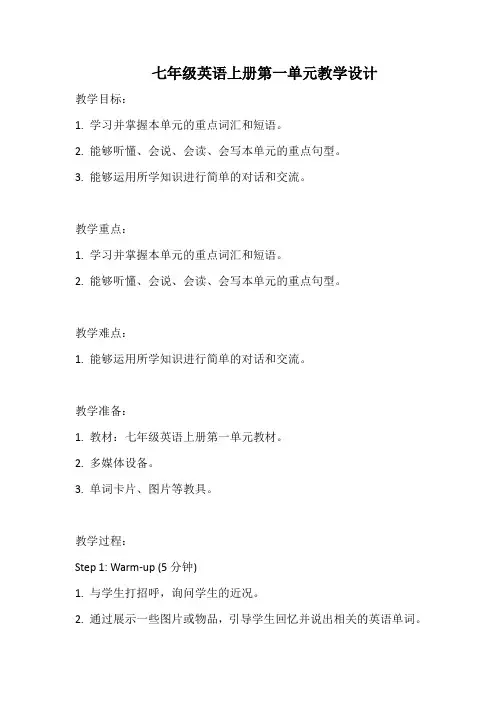
七年级英语上册第一单元教学设计教学目标:1. 学习并掌握本单元的重点词汇和短语。
2. 能够听懂、会说、会读、会写本单元的重点句型。
3. 能够运用所学知识进行简单的对话和交流。
教学重点:1. 学习并掌握本单元的重点词汇和短语。
2. 能够听懂、会说、会读、会写本单元的重点句型。
教学难点:1. 能够运用所学知识进行简单的对话和交流。
教学准备:1. 教材:七年级英语上册第一单元教材。
2. 多媒体设备。
3. 单词卡片、图片等教具。
教学过程:Step 1: Warm-up (5分钟)1. 与学生打招呼,询问学生的近况。
2. 通过展示一些图片或物品,引导学生回忆并说出相关的英语单词。
Step 2: Presentation (15分钟)1. 利用多媒体设备,呈现本单元的重点词汇和短语,帮助学生理解和记忆。
2. 通过图片、实物等方式,让学生猜测和解释新词汇的意思。
3. 教师板书重点词汇和短语,帮助学生进行记忆。
Step 3: Practice (20分钟)1. 听力训练:播放录音,让学生听录音,根据所听内容选择正确的图片或填空。
2. 口语训练:教师与学生进行对话练习,使用本单元的重点句型进行问答。
3. 阅读训练:学生阅读课文,找出关键词汇,理解课文内容。
4. 写作训练:学生根据课文内容,完成相关的填空或写作任务。
Step 4: Consolidation (10分钟)1. 教师与学生一起复习本单元的重点词汇和短语,检查学生的掌握情况。
2. 学生之间进行小组活动,运用所学知识进行对话和交流。
Step 5: Extension (5分钟)1. 教师出示一些与本单元相关的问题,让学生进行思考和回答。
2. 学生自由发挥,运用所学知识进行口头表达。
Step 6: Homework (5分钟)布置课后作业,要求学生复习本单元的重点词汇和短语,完成相关的练习题。
教学反思:本节课通过多种教学方法,如听说读写等,帮助学生学习和掌握了本单元的重点词汇和短语,并能够运用所学知识进行简单的对话和交流。
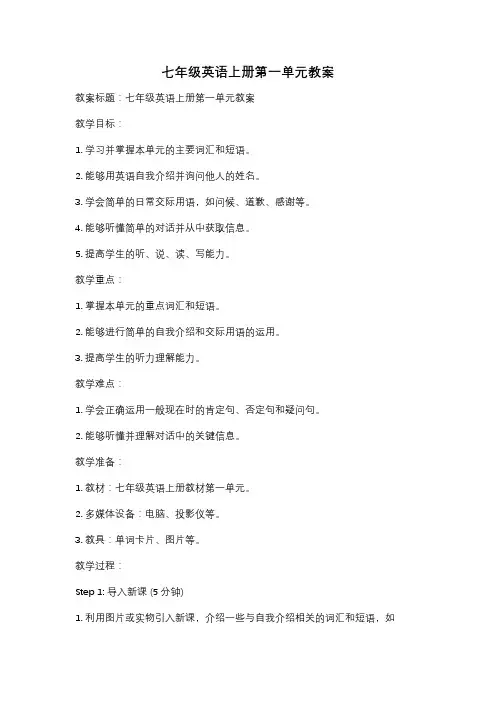
七年级英语上册第一单元教案教案标题:七年级英语上册第一单元教案教学目标:1. 学习并掌握本单元的主要词汇和短语。
2. 能够用英语自我介绍并询问他人的姓名。
3. 学会简单的日常交际用语,如问候、道歉、感谢等。
4. 能够听懂简单的对话并从中获取信息。
5. 提高学生的听、说、读、写能力。
教学重点:1. 掌握本单元的重点词汇和短语。
2. 能够进行简单的自我介绍和交际用语的运用。
3. 提高学生的听力理解能力。
教学难点:1. 学会正确运用一般现在时的肯定句、否定句和疑问句。
2. 能够听懂并理解对话中的关键信息。
教学准备:1. 教材:七年级英语上册教材第一单元。
2. 多媒体设备:电脑、投影仪等。
3. 教具:单词卡片、图片等。
教学过程:Step 1: 导入新课 (5分钟)1. 利用图片或实物引入新课,介绍一些与自我介绍相关的词汇和短语,如name, age, hobby等。
2. 引导学生用自己的方式进行自我介绍,激发学生的学习兴趣。
Step 2: 学习新知 (20分钟)1. 向学生介绍本单元的重点词汇和短语,并进行发音练习和记忆训练。
2. 利用图片或实物进行示范,教授一般现在时的肯定句、否定句和疑问句的用法。
3. 组织学生进行角色扮演,练习使用这些句型进行简单的对话。
Step 3: 听力训练 (15分钟)1. 播放录音,让学生听一段简短的对话,并回答相关问题。
2. 听录音,让学生根据所听到的内容填写相关信息。
Step 4: 合作学习 (15分钟)1. 将学生分成小组,让他们互相进行自我介绍,并用英语进行交流。
2. 老师巡回指导,纠正学生的发音和语法错误。
Step 5: 巩固练习 (15分钟)1. 给学生发放练习册,让他们完成相关练习题,巩固所学内容。
2. 教师检查并批改学生的练习册,及时纠正错误。
Step 6: 课堂总结 (5分钟)1. 教师对本节课的教学内容进行总结,强调重点和难点。
2. 鼓励学生对自己的学习进行反思,并提出问题和建议。
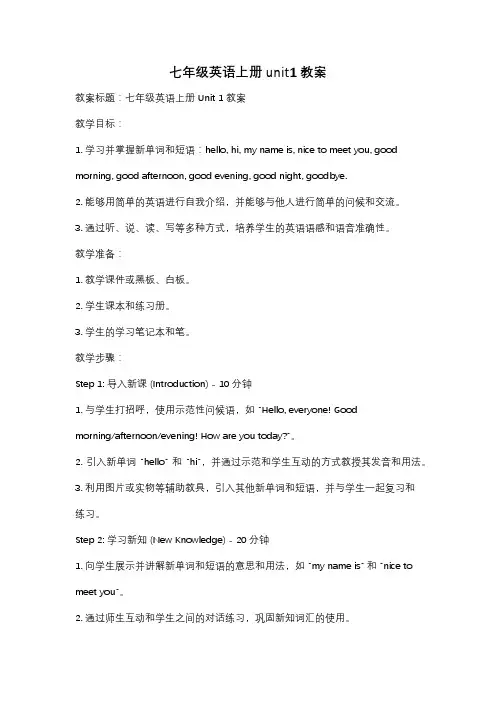
七年级英语上册unit1教案教案标题:七年级英语上册 Unit 1 教案教学目标:1. 学习并掌握新单词和短语:hello, hi, my name is, nice to meet you, good morning, good afternoon, good evening, good night, goodbye.2. 能够用简单的英语进行自我介绍,并能够与他人进行简单的问候和交流。
3. 通过听、说、读、写等多种方式,培养学生的英语语感和语音准确性。
教学准备:1. 教学课件或黑板、白板。
2. 学生课本和练习册。
3. 学生的学习笔记本和笔。
教学步骤:Step 1: 导入新课 (Introduction) - 10分钟1. 与学生打招呼,使用示范性问候语,如 "Hello, everyone! Goodmorning/afternoon/evening! How are you today?"。
2. 引入新单词 "hello" 和 "hi",并通过示范和学生互动的方式教授其发音和用法。
3. 利用图片或实物等辅助教具,引入其他新单词和短语,并与学生一起复习和练习。
Step 2: 学习新知 (New Knowledge) - 20分钟1. 向学生展示并讲解新单词和短语的意思和用法,如 "my name is" 和 "nice to meet you"。
2. 通过师生互动和学生之间的对话练习,巩固新知词汇的使用。
3. 利用课件或黑板、白板等工具,帮助学生记忆新单词和短语。
Step 3: 实践运用 (Practice) - 15分钟1. 学生分组进行对话练习,模拟自我介绍和问候的情景。
2. 鼓励学生积极参与,互相交流和合作。
3. 教师巡回指导,纠正学生的发音和语法错误,并给予肯定和鼓励。
Step 4: 巩固练习 (Consolidation) - 10分钟1. 学生个别或小组完成课本或练习册上的相关练习题,巩固所学内容。
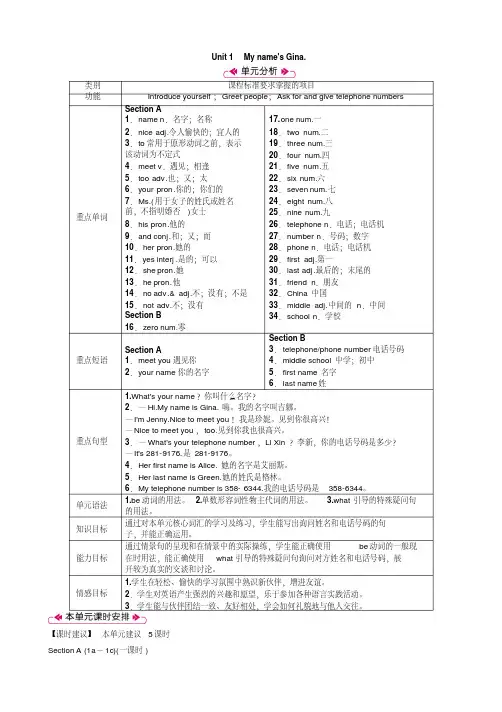
Unit 1My name's Gina.类别课程标准要求掌握的项目功能Introduce yourself;Greet people;Ask for and give telephone numbers重点单词Section A1.name n.名字;名称2.nice adj.令人愉快的;宜人的3.to常用于原形动词之前,表示该动词为不定式4.meet v.遇见;相逢5.too adv.也;又;太6.your pron.你的;你们的7.Ms.(用于女子的姓氏或姓名前,不指明婚否)女士8.his pron.他的9.and conj.和;又;而10.her pron.她的11.yes interj.是的;可以12.she pron.她13.he pron.他14.no adv.& adj.不;没有;不是15.not adv.不;没有Section B16.zero num.零17.one num.一18.two num.二19.three num.三20.four num.四21.five num.五22.six num.六23.seven num.七24.eight num.八25.nine num.九26.telephone n.电话;电话机27.number n.号码;数字28.phone n.电话;电话机29.first adj.第一30.last adj.最后的;末尾的31.friend n.朋友32.China 中国33.middle adj.中间的n.中间34.school n.学校重点短语Section A1.meet you遇见你2.your name你的名字Section B3.telephone/phone number电话号码4.middle school中学;初中5.first name名字6.last name姓重点句型1.What's your name?你叫什么名字?2.—Hi.My name is Gina.嗨。
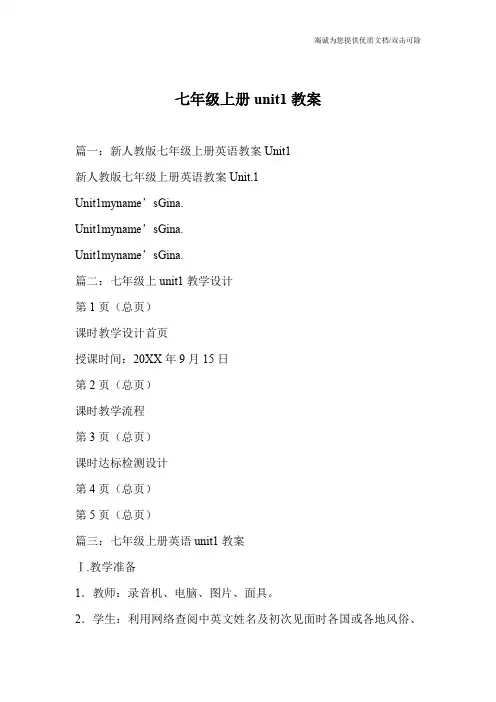
七年级上册unit1教案篇一:新人教版七年级上册英语教案Unit1新人教版七年级上册英语教案Unit.1Unit1myname’sGina.Unit1myname’sGina.Unit1myname’sGina.篇二:七年级上unit1教学设计第1页(总页)课时教学设计首页授课时间:20XX年9月15日第2页(总页)课时教学流程第3页(总页)课时达标检测设计第4页(总页)第5页(总页)篇三:七年级上册英语unit1教案Ⅰ.教学准备1.教师:录音机、电脑、图片、面具。
2.学生:利用网络查阅中英文姓名及初次见面时各国或各地风俗、礼仪的材料。
Ⅱ.教学目标1.学会问候他人。
2.学会做自我介绍,认识新朋友,并正确称呼他们的英文名字。
3.学习本课的知识点。
(1)词汇:name,nice,to,meet,too,your,ms.(2)句型:—what'syourname?—myname's...—Hello!cindy!i'mdale.—nicetomeetyou!what's=whatisi'm=iamname's=nameisⅢ.教学重点难点1.让学生学会做自我介绍,学会交朋友。
2.正确使用问候语。
Ⅳ.教学步骤Step1:Greetingsandtalking运用预备单元学习的Goodmorning!Goodafternoon!Hello/Hi!...等问候语和学生打招呼,拉近了与学生之间的距离,也复习了旧知识。
Step2:Leadin1.利用一些实物,复习“what'sthisinEnglish?”这一句型。
Forexample:T:what'sthisinEnglish?S:it'sabook.T:whatcolorisit?S:it'sblue.2.运用以上句型过渡到课本1a,写出图中物品的英文名称。
初一上册英语第一单元教案英语教案设计是改善课堂教学的一种更高层次的探究,是提高课堂教学质量和效率的一项必要工作,它可以促进教学的系统化,使老师把握讲课节奏。
一起看看初一上册英语第一单元教案!欢送查阅!初一上册英语第一单元教案1教案内容:Teaching aims and requirement1. 会说Hi和Hello,能使用He、Hello相互问好。
2. 会用I’m介绍自己。
3. 激发同学学习英语的爱好,并能在相应的场景中自如地表演运用。
Teaching aidsRecorder and tapeTeaching procedure:第一课时Step 1 Introduction1.师生问候;(师说英语,用手势示意,上课,起立,坐下。
)2.简介英语的重要性,激发同学学习热忱,鼓舞同学学好英语。
Step 2 PresentationTeaching ‘Hi’ and ‘Hello’1.师用Hi、Hello与同学问好,鼓舞同学大胆答复,适当订正同学的读音。
对同学准时赐予表扬。
2.让同学用Hi、Hello自由问好。
Step 3 PresentationTeaching ‘ I’m….’1.师先用中文介绍自己,再用英文说I’m Miss Jiang,放慢语速反复屡次。
2.鼓舞同学用I’m….介绍自己。
(每个同学说完,全班赐予掌声鼓舞) Step 4 Practice1.师用Hi/Hello, I’m Miss Jiang. 与同学问好,引导同学用Hi/Hello, I’m …作答。
2.同学分组用Hi/Hello, I’m 相互自我介绍。
3.唱找伴侣,让同学下位用“Hi/Hello, I’m〞找伴侣。
4.指名上台表演。
5. 引导同学开放想象,让他们在类似的生活场景中运用所学语言。
T: Hello ,I am Miss Jiang .S: Hello ,I am Mike .Step 5 Act用Hi/Hello,I’m…. Goodbye /Bye向全班同学介绍自己。
七年级英语上册Unit1教案Unit 1. This is me!The 1st period Welcome to the unitTeaching aims:1. To use appropriate greetings.2. To introduce oneself.Key points:To greet new friends properly.Difficult Points:Different ways of expressing timeProcedures:Step 1: Self-introductionThe teacher introduces himself or herself to the class, including Chinese name and English name. Then ask several students to tell them Chinese and English names.T: Do you have an English name? How old are you? Where are you from?S: My name is……My English name is Jack. I’m 13 years old. I’m from No. 2 middle school.Step 2: Presentation1. Ask “What’s the time, please?”, and encourage students toanswer it.2. Present a clock, adjust it to a certain place, and ask the studentsto answer what the time is, and how to greet at this time.3. A Game: Divide the students into 4 groups to do the aboveactivity. Look which team wins it.Step 3: PracticeRole play: 4 students a group, make a small dialogue about how to greet at a certain time.Step 4: Read and learn1. Books open to page 32. Part A, read the dialogue and let the students followed.3. Part B, let the students do B1 individually and then checktogether.Step 5: Presentation1. Ask the students about their hobbies (dogs).Let them talk abouttheir dogs’ appearance and names. Teach them the new word“master”.2. Take out a picture of Eddie and Hobo, teach the new words“e-dog, look after”, and review “look up, look like, look at”.3. Let the students read the dialogue on page 2 after the teacher,then ask several students to read it for the class.Step 6: PracticeTeacher: Do you think it’s in the morning? Why?Sl: Yes, they say “Good Morning.”T: What will you say to your friend at this time?8:30 A.M, 2:30 P.M 9:00 P.M10:00 A.M 4:15 P.M 11:45 A.MHomework:1. Make a dialogue in pairs with the knowledge learnt today.2. Copy the new words three times.3. Recite the dialogue on page 2.The 2nd period VocabularyTeaching aims:1. Verbs and nouns about sports.2. Describe different kinds of sports.Key points:Describe different kinds of sports.Difficult Points:1. What do they like?2. What are they like?Procedures:Step 1: Check homeworkAsk several pairs to come to act out their dialogues.Step 2: RevisionSay “We met 6 new friends yesterday, do you remember theirnames?” Let the students answer it.Step 3: Listen and answer1. Let the students listen to the tape with these questions: What are their Chinese names? What do they like?2. Let them write the answers on a piece of paper.3. Listen to the tape again to check the answers and answer:What are they like? Are they short or tall? Are they slim or fat?Are their hairs short or long? Do they wear glasses? Write theunderlined words on the Bb and explain them.Step 4: Read and learnOpen the books and turn to page 4, read after the tape, check“What are they like?” While repeating explain the language points grammatical points. Step 5: ConsolidationDraw this table on the board. Add more columns, one column foradd to the table.Homework:1. Copy new words.2. Write a profile of yourself like what we learnt today.The 3rd periodTeaching aims:1. To recognize the use of language in giving personal information.2. To use personal pronouns correctly.Key points:The use of personal pronouns.Difficult Points:The use of personal pronouns.Procedures:Step 1. RevisionT: Let’s make friends. Hello! My name is … What’s your name?S1: Hello! My name is …T: How do you do!S1: How do you do!T: Hello! My name is … What’s your mane?S2: Hello! My name is …T: Nice to meet you!S2: Nice to meet you, too.(Ask some other students to do this practice.)T: Now, make friends with your classmates.Work in groups of 4.Step 2. Listening and practiceT: Do you remember the six new friends in the book?S: Yes.T: What are their names? Do you remember?T & Ss: Millie, Simon, Sandy, Kitty, Amy, and Daniel.T: Yes, very good. But do you know more about them? What do they like?How old are they? What do they look like?(Students shake their heads.)T: Well, we only know their names, but we don’t know more about them. Let’s listen to the tape, and find out the answers. (Play the tape recorder once.)T: Do they tell you how old they are?Ss: Yes.T: Do they tell you what they like doing?Ss: Yes.T: And do they tell you what they look like? Are they tall? Are they slim? Dothey have short hair or long hair?Ss: Yes.T: OK! Now answer my questions, please.1. How old is Millie? (She is 12 years old.)2. Where does she live now? (She lives in Beijing.)3. What does she like doing? (She likes reading books.)4. What is Simon’s Chinese name? (His Chinese name is Luo Sang.)5. What does he like? ( He likes playing football.)6. What does Sandy like? (She likes listening to music.)7. Does Kitty like sw imming? (No, she doesn’t. She likes dancing.)8. Who likes swimming? (Amy does.)9. Does Daniel like playing computer games? ( Yes, he does.)T: Very good! Now, open your books, and turn to page 6.Look at Part D1. Finish this exercise quickly.T: OK, l et’s check out the answers. What does Millie like?S1. She likes reading books.T: Yes, you are right. What about Simon?S2: He likes playing football.T: Then what about Kitty?…(Write the new words on the blackboard.)(New words: music)T: Well done!Read the whole passage all together. Work in groups, try to finish the table onT: Which group wants to talk about Millie? OK, Group 1, please.(Check out the answers. Write down the new words on the board: short, ponytail, glasses, wear, slim, quite, flat, hard) T: Listen Part A again. Read after the tape sentence by sentence.(Play the tape recorder again.)T: Now say ‘True or false’. Close your books, please.1. Millie is 11 years old. F2. Simon was born in Shanghai. T3. Sandy doesn’t like listening to music. F4. Kitty loves dancing. T5. Amy has black hair in a ponytail. F6. Daniel wears glasses. T7. Millie lives in a flat in Shanghai. F8. Andy is good at maths. T9. Simon’s cousin’s name is Annie. T10. Sandy is short. FStep 3. HomeworkCopy the new words, read the textbook carefully, and write a simple profile of yourself.The 4th periodTeaching aims:1. To recognize the use of language in giving personal information.2. To use personal pronouns correctly.Key points:1. he use of language in giving personal information.2. The use personal pronouns.Difficult Points:1. he use of language in giving personal information.2. The use personal pronouns.Procedures:Step 1. Revision.T: First, let’s have a dictation. Open your dictation books. Write down the date, please: music, ponytail, wear, slim, quite, glasses, flat, short, hard, be bornT: Now, listen to the tape and read after it sentence by sentence. Pay attention to the details. Then answer my questions. (Play the tape recorder.)T: Answer my questions, please.1. Who has a ponytail? (Sandy)2. Who has short hair? (Millie)3. Who has a cousin? (Millie/Simon)4. Who has a dog? What is the name of the dog? (Millie, Eddie)5. Who wears glasses? (Sandy and Daniel)6. Who likes football / basketball / dancing / swimming?(Simon/Andy/Kitty/Amy)Step 2. Doing exercises.1. Open your books and turn to page 5. Look at Part B. Help Millie tocomplete the note from memory. You’d better not look at Part A. I’ll give you 3 minutes.(The students complete the notes.)2. Now, compare your answers with your partner.3: Read the passage on page 4 quickly and check your answers. You should not read every word but just find out the information only. I’ll give you 2 minutes.4. Who can give us his/her answers? Please put up your hands. Good, Tom,you please.(Ask some other students to read their answers and check th e answers all together.)5. This time, read the notes all together. Pay attention to the personalpronouns: she, he.(All the students read the notes.)6. We’ve read the profiles of the six new friends in this book. Can you talkabout yourselves? You may use the sentence patterns in Part A.(Ask some students to give information about themselves.)7. Now, take out a piece of paper, and write a personal profile of a classmate,the class teacher, or anyone else whom we know very well.8. Who can read his/her passage? Jim, you please.(The student reads his passage.)(Ask more students to read their passages and let others guess.)Step 3. Homework1. Listen to the tape for three times; complete the profile of yourselves in PartD2; tell your classmates about the six students; and do the workbook.The 5th periodTeaching aims:the simple Present TenseKey points:The Simple Present Tense(Verb form changes for the simple present tense in the third person singular.) Difficult Points:Different sentences with the third person singularProcedures:Step 1. RevisionRevise some action or some verb phrases.What do you like doing?Revise these verb phrases:swim, read, sing, play football, play games and so on.Step 2. PresentationTask: What do you like to do after school?Do you often go fishing in your summer holiday?Do you like fish?Who else likes fish too?1. Cats eat fish.(things that are always true)2. T: Where do you live?She lives in Beijing.(Things that are true now)T: What do you often do after school; Ss answerWhat does Simon often do after school?He plays football after school (things that we do regularly)Conclusion: The Simple Present Tense is used when we talk about :thing that are always true, things that are true now and thi ngs that people do regularly. Step 3. DrillsGlue them some verb phrases—let them ask and answer with these phrases eg: do houseworkDo you do some housework at home?Who does some housework at home?Does your father/mother do some housework at home?Ask several pairs to act their dialogue.Step 4. Practice (part A)Let Ss complete the sentences with the words in the box. then check their answers.Step 5.PresentationHow to make positive and negative sentences in the simple present tense?We can use one sentence in Part A as a model:eg. I live in a flat in Beijing.I don’t live in a flat in Beijing.Do you live in a flat in Beijing.Yes, I do. No, I don’t.He plays football after school.He doesn’t play football after school.Does he play football after school/Conclude: we add “s” to the verb after “he”, “she” or “it”.However, there are some exceptions.page 9.The table.Step 6.DrillsAsk Ss practice with different pronunciations orally.Eg. He likes reading.He doesn’t like reading.Do he like reading.Step 7.Practise(Part B)1. Ask Ss to complete the dialogue.2. Check their answers3. Ss read the dialogueStep 8.Work out the rule:1. Let Ss write the rule by themselves2. let Ss recite the ruleHomework:1. Recite the new words2. Recite the rule3. Write a similar dialogue as Part B4. Prepare for the next lesson (New words and exercises on page 10-11)The 6th periodTeaching aims:Revise how to use “to be” in the Simple Present Tense and the positive and negative sentences in the Simple Present Tense.Key points:To use “to be” in the Simple Present Tense.Difficult Points:How to use “to be” in the Simple Present Tense.Procedures:Step 1 RevisionRevise positive and negative sentences in the Simple Present Tense with different subjects;Revise like this orally:SA:I do my housework in the evening.I don’t watch TV in the evening.SB: She does her homework in the evening.She doesn’t watch TV.Step 2.Practise (Part C)Millie’s penfriend.1.Do you have a penfriend?Millie’s penfriend e-mailed her some pictures of his family. Do you know who the penfriend is?2 Let Ss read the letter to try to find the answer.(Raymond).3.Let Ss complete the sentences with the correct forms of the verbs.Step 3.Simple Present Tense of the verb “to be”.1. P ositive and negative sentences with “to be” in the Simple Present Tense. Ask Ss make sentences orally like this: T: I am a teacher.S1: I am a student. I am not a teacher.S2: S1 is a student. He isn’t a teacher.S3: S1 and S2 are students.We are stud ents. We aren’t teachers.2. Let them see the table.Step 4:DrillsA: let Ss finish the dialogue on Page 10B:Ask Ss to practise the similar dialogues in pairsStep 5:Presentation1: “To be “is used in the Simple Present Tense in asking and answering questions.Eg:Am I ……? Are you ……? Yes/no. Is she ……?Ss ask and answer in pairs.2: Look at the table on page 11.Step 6.Drills1.Let Ss complete the conversations.2.Check the answers3.Read the dialogueStep 7.Practise (Part F)1: Let Ss complete the letter, then check their answers.2: Pay attention to the pattern of the English letter.3: Some new words and phrasesa: a member ofb. at the weekendc: ran for half an hourd: be good at; do well ine: have dinnerf: restaurantg: sometimesFirst let them guess their meaningsThen introduce them to the students in English.E g: Are you a member of the school football team?Step 8:Homework1.Recite the new words and phrases2.Recite the two tables on Page 10 and Page 11.3.Prepare for the next lesson (New words and finish the exercises on Page12 and Page 13)The 7th periodTeaching aims:1.To train the Ss to read an English article.2.To train the listening skill .3.To train the Ss to read the article .Key points:listen, read , say and writeDifficult Points:The new words: player, sports, score, kick, goal, join, wonderful, Basketball, football, match, the World Cup Procedures:Step 1. Presentation 5Show a picture with a football player kicking a goal .Talking about it with the students .Using the sentences below, try to help the Ss learn the new words.(1)Do you like sports?(2)What sport do you like, football, or basketball?(3)What is your favorite football player?Which football player do you like best?(4)Look at the picture what’s the man doing?(He is kicking the ball. He is kicking a goal. Can he score a goal?(Kick the ball into the goal).(5)Two teams play together that is a---match.(6)What is the biggest football match?The World Cup.Step 2.ReadingRead Part A1, try to finish the notes.Explain the new words.Age: How oldAppearance: What does he look like?Birthplace: Where was he born?Step 3.ListeningListen to the tape, try to find more information about Li Guanhua. Then finish the notes.Step 4.ReadingHelp the Ss read the notes.Step 5.WriteRead Part A1 again, then finish the article.Step 6:WritingOffer some information to the Ss. Ask them to help each other, write an article.(1)姓名:郝海东(2)年龄:33(3)外貌;⾝材⾼⼤,体格健壮(4)出⽣:⼤连(5)职业:⾜球运动员,效⼒于⼤连实德⾜球俱乐部(club)(6)许多⼈喜欢看他的球赛Step 6.ReadingAsk some Ss from different groups to read their articles.Assignment :(1)Write an article about Hao Haidong(2)copy some phrases.Homework: Read part A1 fluently.The 8th periodTeaching aims:1. To establish and maintain relationship and routines in school2. To use everyday expressions to give instructions, make requests, and giveresponsesProcedures:Step 1. RevisionTell the students that they need to speak in English in your class, so it is important to lean some common expressions. Tell them to write down frequently used words and phases in a dedicated book which they should always bring to class.Step 2. PracticeAlternatively, you could create a card system with your students.1. They write phrases on small pieces of cards, one phrase per card.2. Students draw symbols/pictures next to each phrase or instruction to help them memorize the phrases.3. Students show their symbols/pictures to a partner who has to guess what the phrase is.Step 3. PresentationIntroduce the word ‘borrow’. Ask students to work i n pairs to exchange requests and responses as presented on page 14. Ask students to memorize the whole sentences and look at their partner when they speak.Step 4. PracticeWalk around the class and check for understanding. Encourage students to repeat whole sentences from memory. Homework:1. Make a dialogue.2. Copy the new words and phrases.The 9th periodTeaching aims:Writing about yourselfKey points:How to writeDifficult Points:How to writeProcedures:Step 1:Presentation1. The teacher tells each student that they will have a parents meeting, and they must let the parents know them well .ask :How should they do? Get the students to answer. Help them if possible.2. Ask: “How to write a profile?”Step 2: Reading1. Get the student s to read Millie’s and Daniel’s profile by themselves first.2. Ask some questions about the “name, age, birthplace, birthday, hobby, appearance and so on.” Analyze the new words and expressions:Step 3: Presentation and practice1.Ask the students how they can write a profile again .See if studentcan tell you. Help them to say:"Age birthplace birthday…"and so on .2.Practice writing the profile on page 16. Give them about sevenminutes to finish it .Tell them to attend to something.3.Check the answers. First in pairs, then together, share somegood ones.Step 4: HomeworkAsk the students to finish off their profiles. Stick their best photos on it, bring it to school tomorrow.The 10th periodTeaching aims:Check outProcedures:Step 1: Revision1.Ask the students to hand in their homework. Show the pictures tothem and let them guess who he/she is.2.Get one or two students to read the profiles.Step 2: Presentation& practice1.Show them the pictures of the six students in this unit. Asksomething about them:"name, age, birthday, hobby"and etc. Ifthey can’t answer the questions, ask them to open their books.2.Review the vocabulary about sports and equipment.3.Review something about integrated skills.4.Ask the students to group the words on page 17 Part B. Check theanswers and ask them to write down their scores on the paws.Add some words and remind them how to learn and remember thenew words from now on.Step 3: GrammarAsk them to tell something about the simple present tense, write down to be/to do on the blackboard. Analysis how to use "to be"and"todo".Step 4: PracticePractise page17, Part AStep 5: Workbook。
七年级上册unit1教案教案标题:七年级上册 Unit 1 教案教学目标:1. 通过本单元的学习,学生将能够掌握有关自我介绍、问候和交流的基本英语表达。
2. 学生将能够在实际情境中运用所学知识进行简单的交流和对话。
3. 学生将能够培养积极的学习态度和团队合作意识。
教学重点:1. 学习并掌握有关自我介绍和问候的基本英语表达。
2. 运用所学知识进行简单的交流和对话。
教学难点:1. 学生能够在实际情境中运用所学知识进行简单的交流和对话。
2. 培养学生的积极学习态度和团队合作意识。
教学准备:1. 多媒体设备和投影仪。
2. 单词卡片和图片。
3. 学生练习册和笔记本。
教学过程:Step 1:导入(5分钟)1. 通过播放一个有关自我介绍和问候的视频来引起学生的兴趣。
2. 引导学生讨论他们对自我介绍和问候的看法和经验。
Step 2:新知呈现(15分钟)1. 使用多媒体设备展示有关自我介绍和问候的图片,并教授相关的单词和短语。
2. 利用单词卡片进行词汇练习和搭配练习。
3. 通过示范和操练,让学生掌握正确的发音和语音语调。
Step 3:合作活动(20分钟)1. 将学生分成小组,让他们以小组为单位进行自我介绍和问候的对话练习。
2. 每个小组选出一名代表,进行全班展示。
3. 教师进行评价和指导,并提供反馈。
Step 4:巩固练习(15分钟)1. 让学生完成课本上有关自我介绍和问候的练习题。
2. 鼓励学生互相检查答案,并进行讨论和解释。
Step 5:拓展延伸(10分钟)1. 设计一个小组活动,让学生在实际情境中运用所学知识进行简单的交流和对话。
2. 每个小组选出一名代表,进行全班展示。
3. 教师进行评价和指导,并提供反馈。
Step 6:总结和反思(5分钟)1. 教师总结本节课的重点和难点,并与学生一起复习所学内容。
2. 学生进行自我评价,并提出问题和建议。
教学扩展:1. 鼓励学生在日常生活中运用所学知识进行实践和交流。
2. 提供更多的练习资源和学习资料,以帮助学生巩固所学内容。
七年级上册英语第一单元教案英语作为一种语言工具,它的本源特性就是语言功能,在长期的语言使用之中,逐步形成的了英语特色文化。
下面是我为大家整理的七年级上册英语第一单元教案5篇,希望大家能有所收获!七年级上册英语第一单元教案1课前准备教师:准备游戏时所用的图片(食物、蔬菜、动物)。
学生:准备表演时所需道具(服装、假发)。
教学设计Step One :Present the sentence patterns.1. Play a game “How many words do you know?”(利用小游戏调动学生的积极性,同时通过对冠军的介绍引出本课。
)Teacher: After the study of the first three starters, I thinkmost of the students must have known a lot of words. How manywords do you know? Let’s play a game to see who know? Let’s play a game to see who knows the most.(Divide all the students into several groups and show a picture(图片略) to them with the computer. Every group can choose two students to join. They are asked to come to the blackboard and write down the words in 30 seconds.)(Group 2 is the champion group. They can write 11 words.)2. Introduce the champion group to the class.(引课方式贴近生活,学生易于接受)Teacher: Congratulations, now Group 2 is the champion. But I don’t know your names. Would you like to introduce yourselves to us?S1 S2:Yes.S1:Hello.My name is Li Lei. Nice to meet you.Ss: Hello, Li Lei. Nice to meet you ,too.Ss: Hello! What’s your name?S2:I’m Sun Ping. How do you do?Ss: How do you do ?Step Two: Drills.1. Make introductions.(通过句型的操练使学生更加熟练掌握所学的句式。
★精品文档★
2016全新精品资料-全新公文范文-全程指导写作-独家原创
1 / 6
2017七年级英语上册第一单元备课教案
2017
七年级英语上册第一单元备课教案
单元
标题
七年级上册 Unitlynae '
sGina
备课项目
设计区域
备课标
一、语言知识与技能
1.
根据读音规则和音标拼读单词。
2.
理解和领悟词语的基本含义、语法项目以及语言形式 的基本
结构和常用表意功能
;
3
.能在日常交际情景中听懂对话,例如,能听懂连续 的指令
并据此完成任务;能引出话题并进行几个回合的交 谈;
4
.能听懂接近正常语速、熟悉话题的语段和简单故事, 获取
相关信息;
5 .能运用…..词汇和…..
语言形式就熟悉的话题进行 交谈;能
运用…..词汇和…..语言形式及(或)所给提示描述 人、物、事件、
行为、特征等,表达简单的观点;
6.
能在教师的指导下进行简单的角色表演;
★精品文档★
2016全新精品资料-全新公文范文-全程指导写作-独家原创
2 / 6
7
.能连贯、流畅地朗读课文;能从简单的文章中找出
有关信息,理解大意;根据上下文猜测生词的意思;
8. 每天课外阅读量最少达到 100
词。
9.
能运用…词汇和…语言形式以及参照范例 (文章 结构)写出
简单的文段等,包括起草和修改。
二、 文化意识
10.
了解语言和语用的文化因素,体验跨文化交际。
三、 学习策略
11- (1
)利用读音规则和音标拼读词汇,利用上下文、
非语言信息等理解词义,联想学习和记忆词汇,构词法等。
11- (2
)利用情境等理解语法结构和表意功能,发现语
言规律并举一反三。
11-
(3)复习、整理归纳所学内容。
11-
(4)利用预测、语调、重音、问题等来获取听力信
息。
11-
(5)在课内外活动中借助体态语用英语父流。
11-
(6)利用预测、跳读、寻读、细节读等来获取文章
信息。
★精品文档★
2016全新精品资料-全新公文范文-全程指导写作-独家原创
3 / 6
11-
(7)仿写短文,准备素材、起草短文并修改。
11-
(8)明确目标,制定计划,
11-
(9) 了解并跨文化交际(恰当使用)。
四、情感态度
12
.乐于参与英语活动,敢于用英语表达,积极与他人 合作,体
验自己的学习效果。
备教学
重、难点
内容
课标具体知识、技能、文化目标
知识与技能、文化意识的重、难点内容 课标具体策略目标选择
sectionA
sectionB
目标
1
在读写过程中,能够根据读音规则和音标拼读单词。
11-
(1)
11-
(2)
11-
(3)
目标
2
词汇:
★精品文档★
2016全新精品资料-全新公文范文-全程指导写作-独家原创
4 / 6
nae,nice,to,eet,too,your,s.,his,and,her,yes,she,he, no,not.
语言形式:
9/fr
...s < eeuA|iej/
jsei/ueAiB/isjijA■一^eeuAiiej/jsei/ueAiB/jsjipnoAs
< 代
UM(£
7 < usijpON/ sijpseA■一^jeqnueuoqd」noAs!屮s|(
乙
... sueqnueuoqdA/ s <
■一^jeqnueuoqd」
n oAs < jeq/\/\(L
|ooqo seippi'iooqos'eippi'euiqo'pueuj'eeuisei^sefeeuts
」
ij^sjijJeqnueuoqd/euoqdeieV^uoqdJeqnu'euoqdeie
Veuiu^qBie'ueAes'xis'eAijJnoj'eej i|ro/v\rouo'o」oz
:地
euig < |jou < fON/efseA■一乙uoQHnoAai\/(9
eis < eeusiHl < usieq'ON/sieq'seA■一^oefeqsKg
Ajes < eeujeH/ AJBS < ei|S■一乙oeu」oi|s < jeq/\/\(^
□M3S < eeusiH/ou3S < eH—e^usiqs < 代t!M(£
noAjeeoteo!N(乙 ueivs < eeuA/ ueiv < |/ ueiv■一^eeu」noAs <
jeqM(|,
★精品文档★
2016全新精品资料-全新公文范文-全程指导写作-独家原创
6 / 6
目标
3
课堂教学活动中的英语交际
11- (4
)
11- (5
)
目标
4
lb, 2a,2b,
1a,1b,1d,1e
目标
5
1a,1c,2c,2d,3a,3b,3c
1a,1c,1f
11- (5
)
目标
6
lc, 2c,2d
1c , 1f
目标
7
3b
2a,2b,2c.3a
11- (6
)
目标
9
★精品文档★
2016全新精品资料-全新公文范文-全程指导写作-独家原创
7 / 6
3b
11- (7
)
目标
10
1.
了解西方初次见面的礼节
2.
了解英语姓名小常识
11- (9
)
备注:
目标8要求每天课外阅读至少 200词
目标12乐于参与英语活动,敢于用英语表达,积极与 他人
合作,体验自己的学习效果。